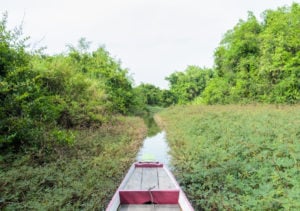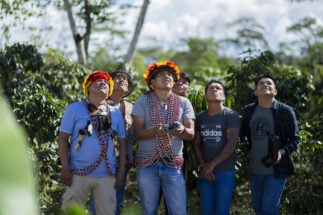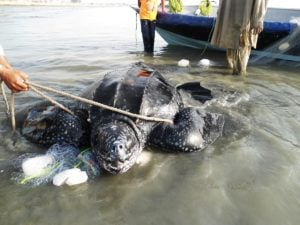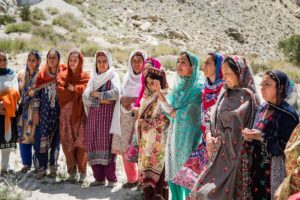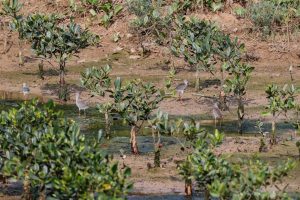In 2020, Martín Maas, a biology teacher at Bacalar’s high school in Mexico’s southeastern Quintana Roo state, invited students Mariana Gil and Gerardo Blanco to participate in a competition to design an environmental conservation project in their community.
The students, who were 16 at the time, decided to work on the reforestation of the red mangrove forest in Lake Bacalar, on Mexico’s Yucatan Peninsula. The lake of seven colours, as the lagoon is also known because of the different shades of blue of the water, is a popular tourist destination. Gil had seen the impact that mangrove deforestation was having on her community first-hand, and was concerned about the ravages of climate change.
“Before, hurricanes affected the town, but we didn’t see as many consequences as we do now,” Gil says. “Now the coastal areas and the low-lying areas of the town are flooding horribly.”
Mangroves act as a barrier against tropical storms: they decrease soil erosion and retain sediment washed down from higher elevations. In the Caribbean region, where Bacalar is located, at least 67 tropical storms were recorded between 1980 and 2019, and at least 14 last year alone, of which eight were hurricanes and two intensified to major hurricanes with winds reaching 111 mph or greater. Without the protection of mangroves, the destruction caused by these storms increases.
The west shore of Lake Bacalar has suffered the greatest loss of mangroves due to urban and tourist development. Bacalar has two of the four mangrove species that are found in Mexico: the red mangrove (Rhizophora mangle) and the buttonwood (Conocarpus erectus). Both are threatened and are protected under the NOM 059 standard, which identifies flora and fauna species at risk of extinction in Mexican territory.

Mangrove rescue
At the local level, the area of mangrove deforestation in the Bacalar lagoon has not been calculated, with data only available at the national and state levels. According to the Mexican Mangrove Monitoring System, in 2020 Quintana Roo had 1,174 hectares of disturbed mangroves (areas of dead or regenerating forest) – equivalent to more than 1,600 football fields.
In Mexico as a whole, mangroves cover more than 905,000 hectares, according to data from the National Commission for the Knowledge and Use of Biodiversity (CONABIO). The country has one of the top-10 highest rates of mangrove loss in the world, with an average of 10,000 hectares lost every year.
News of this degradation galvanised the students to take action. They collected red mangrove seedlings in a state reserve in Bacalar. Using plastic containers and old tarpaulins they built their own version of a chinampa – a 700-year-old Aztec farming technique – in which they cultivated the seedlings. They placed netting over the top of the chinampa to provide shade.
“We saw that we could make chinampas at school and we didn’t have to spend money on greenhouses, because we could do everything with recycled material,” says Gil. “[The project] could be replicated on a larger scale in schools and society.”
Gil took the chinampa to her backyard and, over the course of 2020, she monitored the growth of the seedlings and the conductivity of the water (its ability to conduct heat or electricity) on a monthly basis until they were ready to be replanted in the lagoon. Maas explains that the water’s conductivity is a measure of its quality.
“I had them from seedlings,” Gil says. “I took care of them all the time and watched them grow. That motivated me to continue with the project. I grew fond of them.”
Although it was only a pilot project, of the six seedlings that were replanted, three survived and remain in the lagoon. “The objective we had was to see if the mangrove seedlings would adapt to a home environment of plastic chinampas, and the results were good,” says Maas.
In 2022, Gil and Blanco won medals in two international science competitions. They are displayed inside Maas’s biology lab at the school.

Next steps
However, there is a legal hurdle to continuing and extending the project, Maas says. Because the red mangrove is protected by the NOM 059 standard, permission must be requested from the environment ministry (SEMARNAT) to create an environmental management unit, land designated for sustainable use and environmental conservation where the plants can be cultivated. This applies even to small projects in someone’s backyard. But Maas is not fazed: “Once we have all of that, the project can really get underway,” he says.

More broadly, mangrove reforestation has its limitations as a conservation approach. While it does help to increase the number of mangroves, it is not comparable to restoration actions, where the causes of coastal erosion are fully investigated and tackled, usually by scientists or civil society.
If there are changes in hydrology that affect the mangrove, bioengineering can be used to open channels and create more powerful water routes that can help conserve the ecosystem more effectively than reforesting, says Héctor Hernández, a researcher in marine ecology at El Colegio de la Frontera Sur, a centre for scientific research focused on sustainable development.
Ecological restoration of a mangrove swamp involves an integrated approach, in addition to reforesting seedlings
“Ecological restoration of a mangrove swamp involves an integrated approach, in addition to reforesting seedlings,” says Hernández. “It’s about protecting the shoreline so that what is planted or what is deposited naturally can grow.”
However, the researcher believes the importance of Gil and Blanco’s project in Bacalar lies in the impact it has had on the other students. “For me, the work that Martín Maas is doing is extremely valuable, because it has an educational component, raising awareness of the environmental value of the ecosystem,” he says.

Mexico’s environment ministry has recognised that environmental education “is not a priority in the context of national education policies”, and that in order to promote this field, there is a need for more environmental educators in political spaces, funding for environmental education projects and teacher training, among other measures.
In this context, projects like the one undertaken at Maas’s high school take on greater meaning. Gil and Blanco’s peers have seen their idea win recognition in international competitions, which has inspired them to follow in their footsteps.
As Cristopher Soto, another of Maas’s students, says: “Yes, we would be interested in [getting involved]. When Mariana [Gil] showed us her project, we realised that if [the chinampas] have worked since ancient times, so why not now?”
This story had the support of the Red de Periodismo del Mar (Repemar), promoted by Causa Natura with the help of the Earth Journalism Network of Internews


